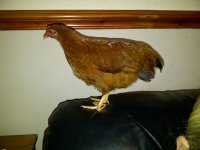A
Anonymous
Guest
Just went to buy some geese and saw this all alone in a small cage and had to buy it.. The woman said it was a hen but im not sure, dont even know the breed... It has a broken toe which seems to have been like that a while, it wont streighten out anyway. I felt sorry for it so had to take it.. Should I get the toe looked at? Anyonw know the breed? I tried to put it out with our hens and we have a rhode island red cock, He was jumping n it so brought it back in.. Is it best to keep them seperate or introduce slowly?
Thanks, Shaun
Thanks, Shaun

